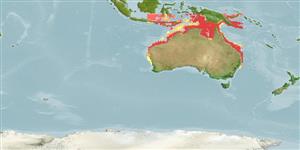>
Carangaria/misc (Various families in series Carangaria) >
Polynemidae (Threadfins)
Etymology: Polydactylus: Greek, poly = a lot of + greek, daktylos = finger (Ref. 45335).
More on author: Günther.
Environment: milieu / climate zone / depth range / distribution range
Écologie
marin; saumâtre démersal; profondeur 10 - 56 m (Ref. 45356), usually 10 - 56 m (Ref. 45356). Tropical; 4°S - 34°S, 113°E - 154°E (Ref. 57343)
Eastern Indian Ocean and Western Pacific: known only from southern Indonesia (Timor and Arafura seas) and northern Australia (Exmouth Gulf, Western Australia to Clarence River, New South Wales) (Ref. 9685). The type locality (China) may most likely be erroneous.
Taille / Poids / Âge
Maturity: Lm ? range ? - ? cm
Max length : 21.0 cm FL mâle / non sexé; (Ref. 1844); 24.5 cm FL (female)
Inhabits coastal waters over sand or mud bottoms. Feeds on prawns. Often taken in association with Penaeus prawns in the Gulf of Carpentaria.
Life cycle and mating behavior
Maturité | Reproduction | Frai | Œufs | Fécondité | Larves
Sex change occurs between 12-14 cm SL (Ref. 45356).
Motomura, H., 2004. Threadfins of the world (Family Polynemidae). An annotated and illustrated catalogue of polynemid species known to date. FAO Spec. Cat. Fish. Purp. Rome: FAO. 3:117 p. (Ref. 57343)
Statut dans la liste rouge de l'IUCN (Ref. 130435: Version 2024-1)
Menace pour l'homme
Harmless
Utilisations par l'homme
Pêcheries: sans intérêt
Outils
Articles particuliers
Télécharger en XML
Sources Internet
Estimates based on models
Preferred temperature (Ref.
123201): 25.4 - 28.7, mean 27.7 °C (based on 632 cells).
Phylogenetic diversity index (Ref.
82804): PD
50 = 0.5000 [Uniqueness, from 0.5 = low to 2.0 = high].
Bayesian length-weight: a=0.00794 (0.00468 - 0.01347), b=3.12 (2.97 - 3.27), in cm total length, based on LWR estimates for this species & Genus-body shape (Ref.
93245).
Niveau trophique (Ref.
69278): 3.1 ±0.30 se; based on food items.
Résilience (Ref.
120179): Milieu, temps minimum de doublement de population : 1,4 à 4,4 années (K=0.16).
Fishing Vulnerability (Ref.
59153): Low vulnerability (17 of 100).
